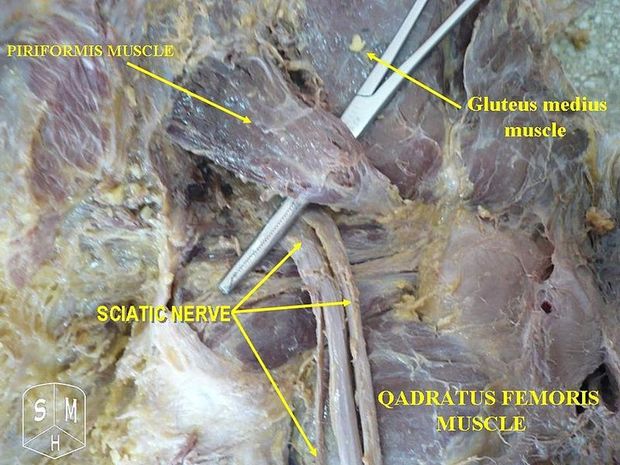PIRIFORMIS SYNDROME REVISITED
PIRIFORMIS MUSCLE AND SCIATIC NERVE UNDERNEATH
|
“About 5 million of the 26 million Americans who suffer from low back pain each year have piriformis syndrome. Piriformis syndrome produces an intense, sometimes crippling pain deep in the butt cheek, usually just on one side….. Even though your back is flawless, the piriformis muscle in the buttock may tighten, go into spasm and entrap the sciatic nerve, causing the same symptoms and misery that come with herniated disks. Those who compile statistics declare that piriformis syndrome may account for as much as 50 percent of the pain that strikes in the backside and radiates down the back of the leg….. Many internists, neurologists and pain specialists aren’t very familiar with this problem, and mistakenly think the source of the pain is in spinal nerve roots. Because it is so easy to confuse with herniated disk, piriformis syndrome can be extremely difficult to diagnose, partially because MRIs and X-Rays don’t pick it up.”
|
Of this Piriformis Syndrome, not all of it is alike. Some Piriformis Syndrome is caused by congenital issues or poorly understood factors that I have no answer for. These people are more likely to show positive findings with specific EMG testing. However, I would argue that the majority of the cases of Piriformis Syndrome will never test positive on an EMG. These are the people whose Piriformis Syndrome is largely the result of FASCIAL ADHESIONS and / or TENDINOSIS. I also believe that a fair number of these people have SYSTEMIC FASCIAL ADHESIONS as well; or maybe THORACOLUMBAR ADHESIONS. For more information on Piriformis Syndrome, take a few minutes to read my PIRIFORMIS SYNDROME BLOG POSTS.
I certainly do not claim to have all the answers when it comes to successfully treating Piriformis Syndrome. However, I can tell you that if your pain is being caused by problems in the Fascia or Tendons, you will see positive results after just one treatment. This is what I told “E” who out of sheer desperation, made a tough 3 hour drive to see me on Monday after doing THIS TEST. Here is the email I got from her last evening. She has a disc problem (VERIFIED WITH MRI) and a Piriformis Syndrome —- the later of which was being worsened by Spinal Decompression Therapy; something I have discussed many times on previous blog posts on this topic.
The pain I felt in my calf muscle after the tissue remodeling has remained and even intensified. The pain in my hip / glute is noticeably decreased. I’m even not feeling the pain with coughing that I was having before. I feel confident that the treatment did something positive for me even though it may not save me from surgery. Thank you!
E

